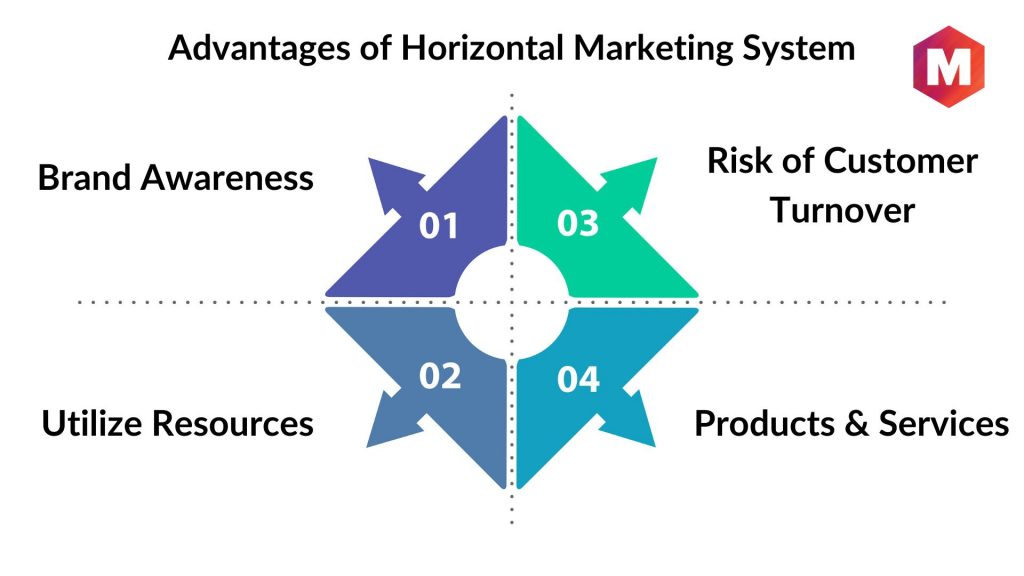Given the current state of the economy, companies from many industries need help to sustain the same profits that they enjoyed in the mid-2000s, before the well-known mortgage crisis. Given the unstable external business climate, businesses must devise unique and creative strategies to maintain high customer awareness.
One of these inventive and creative alternatives is the horizontal marketing strategy, which Kotler and Armstrong have researched. Horizontal marketing focuses on integrating financial, production, and marketing resources. Combining these three factors is intended to do far more than any concept acting independently.
Table of Contents
What is Horizontal Marketing?
Horizontal marketing is a strategy that involves marketing to a wide audience. It is typically used in the B2C (business-to-consumer) but also B2B (business-to-business) situations.
The main goal of a horizontal marketing strategy is to reach as many people as possible. In some cases, this means targeting an entire country or continent; in others, it means reaching out to many people from one city or state.
Some companies use horizontal marketing systems to help grow their brand exposure and generate more revenue (while not launching new advertising campaigns). They create campaigns that appeal to their target audience without alienating other potential customers.
New companies often use A horizontal marketing system to build a customer base. It can also be used by large corporations that want to reach more people while maintaining the brand identity they have already established.
A Horizontal Marketing System (HMS) strategically broadens the marketing scope, shares resources, and reinforces competitive advantages. Here are a few sample structures for HMS:
- Combined Branding Collaborations: This occurs when numerous companies collaborate to create a product or service that combines each brand’s unique benefits. Such collaborations provide an opportunity to reach a bigger audience while utilizing each other’s unique skill sets. For example, a major coffee brand collaborates with a leading electronics business to provide smart coffee equipment.
- Shared ventures: Businesses form new organizations to explore a certain business opportunity, evenly distributing resources and uncertainties. This combines their strengths and allows them to enter previously untapped sectors, such as a well-known automaker collaborating with a tech titan to manufacture electric automobiles.
- Cross-Promotion Collaborations: Businesses work together to promote their products or services. This arrangement promotes collaboration, allowing access to a larger audience. For example, a movie release is marketed alongside a fast-food chain’s new menu item.
- Strategic Partnerships: Businesses form alliances to achieve common goals, such as entering new markets or launching innovative goods. Such alliances assist in sharing resources and expertise and circulating nodes for mutual benefit. For example, a clothing firm may collaborate with a recycling company to launch an eco-friendly clothesline.
- Sectorial Consortiums: Businesses in the same industry band together to address common challenges or capitalize on shared opportunities. Collaborative actions in research, development, and marketing lead to mutual success. For example, many renewable energy companies are working together to address climate change challenges.
A Horizontal Marketing System (HMS) is designed and targeted around the firms involved and their industrial landscape. Examples of HMS include couplings between Spotify and Uber, Samsung and Spotify, and Starbucks and Barnes & Noble.
Why use Horizontal Marketing?
All businesses, regardless of industry or niche, must be able to sell their products and services to customers. While vertical marketing is still a useful strategy, businesses must ensure they’re reaching their customers through multiple channels.
This is where the horizontal marketing strategy comes in. Horizontal marketing helps you reach your customers across multiple platforms and channels, which can help you build brand loyalty and increase your customer base.
Horizontal marketing is essential for small businesses that don’t have the resources or expertise to do any vertical marketing on their own. This is why many small businesses work with agencies specializing in horizontal marketing strategies—they help ensure that every part of your business’s message reaches as many potential customers as possible.
Horizontal marketing is also important because it allows you to reach out to new audiences that may not have heard about your brand before. For example, suppose you’re a small business owner in San Francisco and want to expand your operations into Los Angeles. In that case, horizontal marketing can help you reach out to people in Los Angeles who may not know about your company yet but would benefit from using your services or products if they did!
And finally, horizontal marketing helps you expand your business to new markets, making it easier for customers to find you. This strategy has advantages over other marketing methods because it focuses on people rather than just products or services.
Types of Horizontal Marketing Systems
Horizontal marketing systems exist in three main arrangements:
- Multi-manufacturers: In this arrangement, manufacturers or producers exploit their combined resources efficiently, increasing efficiency and production. This collaboration enables them to address resource scarcity or capitalize on shared strengths.
- Multi-wholesalers: The primary goal is to extend market reach and distribution capabilities across vast territories. Collaboration allows wholesalers to gain larger distribution, offer diverse product offerings, and reduce competition pressures by pooling their networks and resources.
- Multi-retailers: Such alliances involve retailers joining forces to reap the benefits of bulk purchasing, enhancing their negotiation power and ability to fulfill large orders. This collaboration results in cost savings and increased market penetration in targeted locations.
Illustrating each kind with inventive but feasible examples:
- Imagine Volvo and Tesla combining their skills to develop a new line of electric, self-driving commercial trucks, leveraging their shared technology and manufacturing facilities.
- FedEx and DHL might develop a strategic agreement to expand their global logistics and delivery networks, allowing customers to receive more efficient and far-reaching deliveries.
- Walmart and Target may form a cooperative purchasing operation to negotiate better deals from suppliers on vital goods, pass savings on to customers, and strengthen their competitive position.
These examples show how diverse horizontal marketing systems can work together to provide mutual benefits while meeting unique market needs and consumer desires.
Examples of Horizontal Marketing Systems
Before we discuss this topic in more detail, we should consider horizontal marketing. The most well-known example is the collaboration between Apple and Starbucks.
When it introduced iTunes, Apple entered an exclusive partnership with Starbucks and allowed Starbucks Wi-Fi users to browse, download, and buy songs from the Apple iTunes store. Apple benefits from this partnership with higher iTunes sales because Starbucks has a lot of loyal customers who take the time to visit, relax, and enjoy the unique Starbucks experience. When Apple first introduced its iTunes music store, it hoped to sell one million songs in six months, but to its surprise, Apple sold over one million songs within the first six days of its iTunes music store opening. Much of the contribution was from Starbucks stores.
Similar examples of Horizontal marketing systems involve collaborations ranging from Henry Ford’s buying ships and railroads—and even a rubber plantation in Brazil to ensure his supply of tires—to Boeing’s radical outsourcing of Dreamliner components and, more recently, back to greater ownership of upstream and downstream assets by companies as different as Pepsi and Oracle.
Some companies within a product or service category are also part of an alliance. Passenger air carriers such as Finnair, British Airways, etc., are part of the One World Alliance, meaning they have many connecting flights. Thus, the alliance airlines can increase passenger volume through travel agents who book travelers on these carriers. The premise for the alliance is that travel agents that book passengers on one airline will more than likely book the same passengers on connecting airlines within the alliance.
These examples give you a fair idea of horizontal marketing. When one or more companies align to create a unique strategy that benefits all the entities involved, this act is known as Horizontal marketing.
Horizontal Marketing Methodologies
Companies can use horizontal marketing tactics to exploit synergy and expand their market reach.
- Collaborating on new solutions draws a varied customer base.
- Another method is to increase visibility by promoting products together.
- Exchanging expertise improves project outcomes.
- Sharing logistical channels improves the efficiency of product distribution.
Advantages of Horizontal Marketing System
The most popular form of business marketing is horizontal marketing. In this system, a business can sell its products or services to other businesses rather than directly to consumers.
Let’s take a look at some of the advantages of horizontal market systems:
- It can increase brand awareness because it allows you to reach more people than if you were only focusing on one industry or market share
- You can create synergy between products and services
- It allows you to utilize resources within your organization more effectively
- It reduces the risk of customer turnover because each product or service offering targets a different segment of your market.
- It allows you to offer different products and services while maintaining brand loyalty. Customers already loyal to a specific brand are unlikely to switch brands when they purchase new items from that brand.
Finally, the biggest advantage of horizontal markets is that they decrease competition within each market segment, so consumers are less likely to overlook individual products or services!
Vertical Marketing vs Horizontal Marketing – Key differences
Horizontal marketing is different from vertical marketing systems. In vertical markets, the target customers are two different companies operating in different industries. In horizontal marketing, the companies involved have similar product lines in the same industry. They cater to the same target market in the same industry.
For example, a company that sells a product to a specific industry is said to be in a vertical market. If you sell school supplies, you are considered to be in the education vertical market; if you sell tools, you are in the tool industry.
The horizontal marketing system approach, on the other hand, mainly addresses two or more companies focusing on increasing the customer base without actually increasing the marketing budget.
As the core center of this strategy relies on the target market, it is natural to conclude that the companies in horizontal marketing partnerships want to reach the target audience that shares interests and demographic characteristics.
Most examples of horizontal marketing partnerships mentioned above have one thing in common. They all started with acknowledging the opportunity to partner with another company to bring a new product.
The involved companies generally tie up to increase the value of their offerings, such as in production, distribution, or marketing. An increased value offering brings in more business for the companies involved in Horizontal marketing. A basic rule of this concept is that both companies involved have to be in a win-win situation, and every step taken in realizing the partnership should be mutually convenient.
Here is a video by Marketing91 on Horizontal Marketing.
Conclusion
In conclusion, horizontal marketing systems are a purposeful and collaborative way to increase market reach and brand visibility. By pooling their resources, skills, and networks, businesses from multiple industries may unleash synergies, promote innovation, and reach larger audiences more efficiently.
Horizontal marketing, whether through integrated branding collaborations, joint ventures, cross-promotion methods, or strategic alliances, provides a versatile and effective option for businesses navigating the complexities of modern marketplaces. Embracing this practice allows organizations to overcome traditional marketing restrictions and promotes mutual growth, laying the groundwork for long-term success in an ever-changing economic landscape.
Liked this post? Check out the complete series on Marketing





You’ve said that in Horizontal marketing, companies involved are similar companies with similar product lines.
But In the case of Apple and Starbucks the companies are from different industries and the later is a service offering company.
Can you throw some light on it.
Dear Paras, In this case, we are talking about the Apple Itunes store which is also a service.
We are not talking of the Apple Macbook which is a product. Apple could not sell the Apple itunes in stores. So it approached a retailer who was also in the service industry and where people went to relax and have fun. Hence it is an example of horizontal marketing where two different companies in similar industries are interacting.